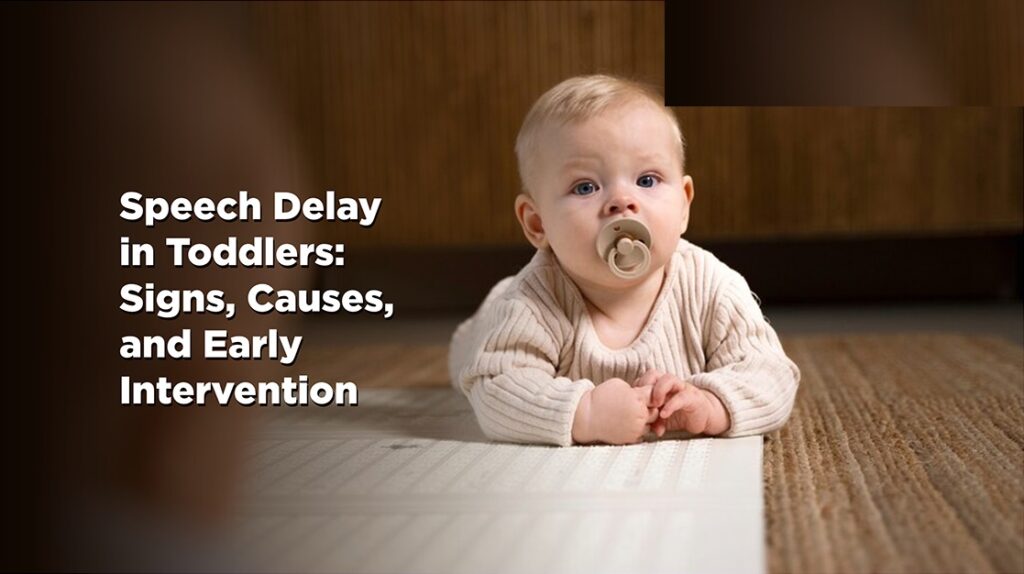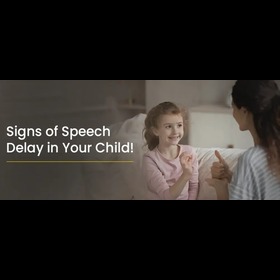Children develop speech at their own pace, with the first words typically emerging between 12 and 18 months of age. As with other skills and milestones, the age at which children learn language and begin talking can vary. However, some toddlers may experience a speech delay if they aren’t meeting certain developmental milestones.
Speech and language delays can affect a child’s ability to hear, process, or produce sounds, which impacts how they communicate and learn. Early awareness is essential.
Let’s explore what speech and language delays mean, how to spot the signs, and why early identification and intervention can make all the difference in a child’s development.

What is speech delay
Speech delay, also known as alalia, is characterized by a delay in the development or use of the mechanisms that produce speech or language at an expected rate for their age.
Speech: It is the verbal expression of language and includes articulation (the way we form words and sounds).
Speech includes:
- How do we make speech sounds using our lips, tongue, and mouth
- Voice, or how we use breath and vocal folds to make sounds
- Rhythm, fluency, and smoothness of how we speak
Language: It is giving and getting information in a meaningful way. Understanding and ability to be understood through communication (verbal, nonverbal, and written).
Language includes:
- Knowing how to put small words together into big sentences
- Understanding what words mean
- Knowing how to talk with people in different situations
Difference between speech or language delay
Speech and language delays are different; however, they often overlap. Speech is the ability to express language verbally with proper articulation, while language is the act of giving and receiving information.
A child can have a language or speech delay, but some children may experience both simultaneously.
If a child has a speech delay, they may be able to form phrases and words to express their ideas and thoughts, but they may lack the ability to pronounce them well enough for others to understand.
If a child has a language delay, they develop language skills in the right order, but at a rate that is slower than expected.
A child with a speech or language delay may find difficulties understanding words and using verbal language to share their feelings and needs, or they may experience difficulty physically forming and articulating the words they want to use.
Signs of a speech delay
The main symptom that is seen in kids with speech delay is that they may speak only a few words, or they cannot speak at all. The other common signs include
- Trouble with imitating words or sounds
- Frustration in expressing needs and wants
- Speaking less or using fewer words than kids of the same age
- Problems with understanding
- Difficulty pronouncing sounds
- Inability to follow instructions
- Lack of gestures
Other problematic signs that need immediate attention:
- Not babbling by 6-12 months
- Not speaking any words by 18 months or by 24 months
- Not combining words
- Not using 2-word phrases by age 2
- Slow or stalled speech development
- Difficulty understanding the child’s words even after 36 months
Developmental milestones by age
AGE 0 – 1
Usually, kids develop language speaking skills around 4-6 months of age, making babbling sounds and understanding their surroundings with laughter. From 7 months onwards, your little ones make basic sounds like apple, cup, etc, and react to these sounds. By the age of 1, they often continue babbling with hand gestures.
If the baby is not cooing or making any other sounds in the first 2 months, it could be the earliest sign of a speech delay.
AGE 1 – 2
By the age of 2 years, a child should be able to understand simple commands, questions, and basic body parts, noticeably learning new words, and begin to use some 2-word combinations. Reacts to things like toys, pictures, songs, or stories and begins to ask simple questions.
AGE 2-3
Within the third year of life, a toddler starts using 2–3-word combinations with more regularity. A typical 3-year-old is able to use about 1000 words. At this point, parents are able to understand their speech.
AGE 3-5
During this age, kids start having longer conversations and talk in complete grammatically correct sentences by the age of 5, in their native language.
A child with a speech delay by a certain age may exhibit the following signs:
- Age 2: Your child may use fewer than 50 words
- Age 2 or 2 and a half: Your child doesn’t use unique 2-word phrases or noun-verb combinations
- Age 3: Your child doesn’t use at least 200 words, can’t spell their name, and it’s hard to understand their words
- Any age: Some children are unable to say previously learned words.
What causes a speech or Language delay?
Speech and language delays can occur in kids for various reasons, and they can affect a child’s ability to communicate effectively.
A child may experience language or speech delay due to an underlying physical condition.
A speech delay can be caused by various factors, including oral-motor problems, such as coordinating the lips, tongue, and mouth to pronounce sounds properly. In certain conditions, for example, ankyloglossia (tongue-tie), which is characterized by the connection of the tongue to the floor of the mouth, affects 4-10% of the population, making it difficult to create certain sounds, particularly D, S, L, Th, R, T, and Z.
Other reasons:
- Hearing loss
- Developmental delays
- Neurological conditions (cerebral palsy, traumatic brain injury, muscular dystrophy)
- Speech sound disorders
- Selective mutism
- Environmental factors (lack of adequate language stimulation)
Risk factors:
- Family history
- Premature birth
- Trauma
When to consult a specialist
Every child develops speech at their speed, and some focus on learning one skill first over others. However, if your child is not saying around 50 unique words and forming 2-word sentences, a screening will be recommended to see if your child is just a late talker or if they have an underlying condition.
Your speech-language pathologist (SLP) or sleep therapist examines the speech and language skills of the child. They do some standardized tests and look for milestones in language and speech development.
- Parent/Caregiver Interviews: The doctor takes the information about the child’s communication from parents or caregivers, including first words, babbling, sentence formation, and overall communication patterns.
- Standardized language assessments: SLPs use standardized tests to assess various aspects of language, including what the child is saying (expressive language) and whether the child is understanding (receptive language).
- Speech and Articulation Assessments: Evaluates the child’s ability to produce speech sounds and pronounce words clearly to check sound development and clarity of speech.
Doctors also do the other assessments, such as
- Oral-motor and feeding evaluation
- Hearing screening
- Autism screening
- Dynamic assessments (to test children’s learning and problem-solving abilities)
- Developmental milestone checklists
Therapy options and home support
Speech–language therapy
It is the first line of treatment for speech or language delays, especially if the speech is only a developmental delay. A speech therapist will work with the child to improve the speech and language skills and give the child some tips to follow at home.
During this therapy, the doctor:
- Helps the child in learning how to use gestures to help them communicate better
- Helps the child formulate phrases, words, and sentences, helping him to speak and read more clearly
In speech therapy sessions, doctors help the parents learn the activities and strategies to use at home to support their child’s speech and language development.
Speech-language pathologists not only target attention, comprehension, and expression goals but also play, memory, social communication, and reasoning skills.
Tracking progress over time
To track a child’s speech delay progress, parents can watch and note how their child communicates during daily activities. Working with therapists and using pictures or visual tools can help. It’s important to keep track of milestones, any difficulties, and the support the child needs. Regular check-ins with a speech therapist help improve plans and celebrate progress.
Conclusion
Speech and language delays occur when children don’t reach communication milestones at the expected age. These delays may affect how they understand or express language and can be caused by various factors like hearing loss, developmental conditions, or oral-motor issues. Early signs include limited vocabulary, trouble forming sentences, or difficulty being understood. Early diagnosis, therapy, and active parental involvement are key to helping children improve their communication skills and overall development.
FAQ’s
A speech delay is characterized by an inability to develop speech and language skills at the expected pace.
Causes of speech delay include oral motor problems, developmental delays, neurological conditions, speech sound disorders, selective mutism, and environmental factors.
A speech delay affects how the children say things, but a language delay affects what the children say.
The speech therapy helps to improve speech and language skills and gives insights to parents on what to do at home to help their child.
Speech delay can be diagnosed through interviewing parents and caregivers, standardized language assessments, speech and articulation evaluations, and sometimes hearing screenings and other specialized assessments.
By 18 months, if your child isn’t using consistent words, or by 24 months, they’re not combining words, it may be a sign of delayed speech. Other signs include slow or stalled speech development, difficulty understanding your child at 24 months, or strangers still struggling to understand them by 36 months.
To help a child with delayed speech, parents should focus on creating a language-rich environment, practicing speech exercises at home, and seeking professional help if needed.




